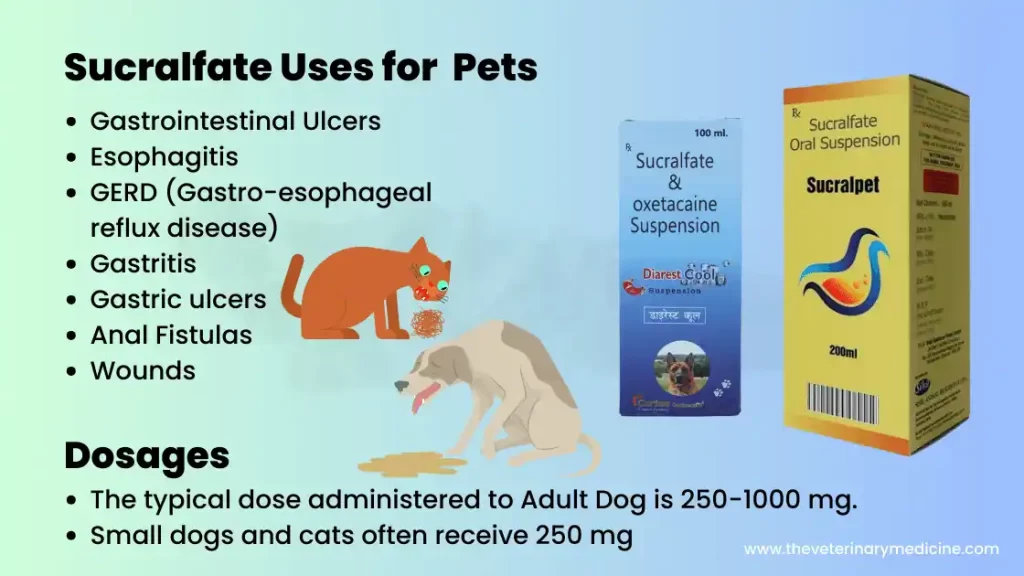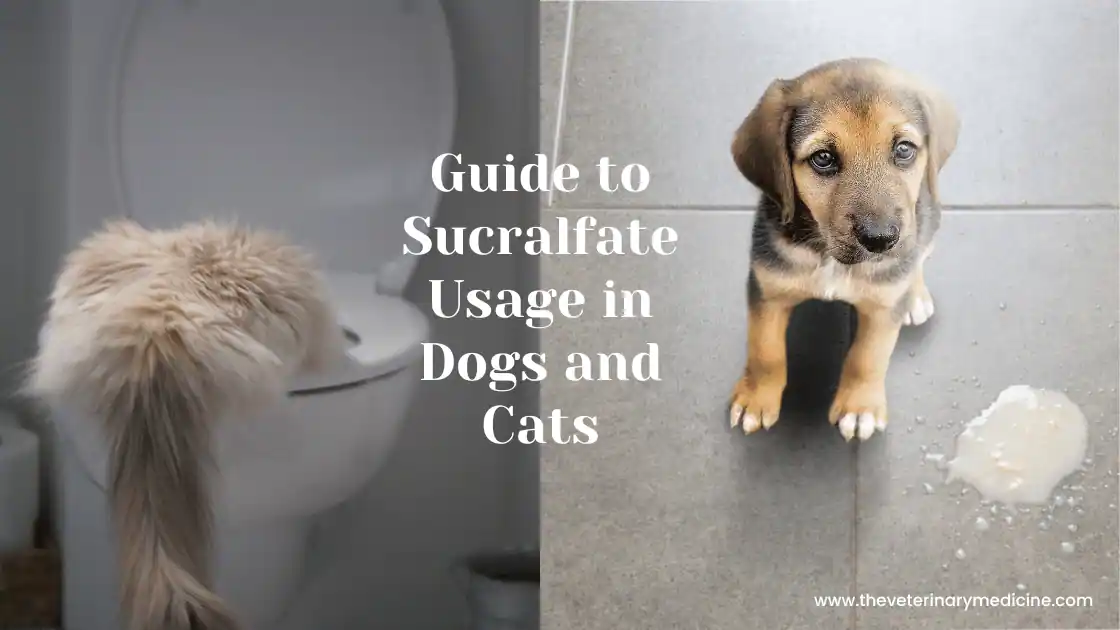Introduction:
Gastrointestinal issues like vomiting, GERD, esophagitis, gastritis, gastric ulcers, diarrhoea etc. are common in dogs and cats due to many etiopathologies. Gastrointestinal issues in dogs and cats can be challenging for both pets and their owners. Sucralfate, a medication renowned for its mucosal protective properties, emerges as a promising solution for treatment of many of gastrointestinal disorders in veterinary medicine. Its unique mechanism of action, forming a protective barrier over ulcers and inflamed tissues, sets it apart as a therapeutic option.
This blog post aims to provide a detailed insight into sucralfate usage in dogs and cats, covering indications, dosage, side effects, precautions, and even exploring the potential synergistic effects of sucralfate when combined with oxetacaine, offering a holistic approach to gastrointestinal health in dogs and cats.
Mechanism of Action of Sucralfate:
Sucralfate, an aluminium salt of sucrose sulfate, undergoes partial hydrolysis in acidic pH, forming a sticky paste. This paste adheres to the mucosal lining of the gastrointestinal tract, creating a protective barrier that shields against gastric acids, pepsin, and bile salts. This mechanism promotes healing by preventing further damage to gastrointestinal lining/ mucosal lining and allowing the natural regenerative processes to occur.
Sucralfate can be used in combination with PPI or proton pump inhibitors like ranitidine, pantoprazole etc for better efficacy and results in GI disorders. It is also indicated in ferrets, reptiles and horse for GI ulcers or irritation.
Indications for Sucralfate Usage:
Gastrointestinal Ulcers: Gastrointestinal ulcers, a common ailment in pets, can cause discomfort and lead to complications if left untreated. Sucralfate’s ability to create a protective barrier makes it an effective choice for managing and healing ulcers in the stomach and intestines.
Esophagitis and GERD (Gastro-esophageal reflux disease): Esophagitis, inflammation of the esophagus, can result from various causes, including acid reflux. Sucralfate’s coating action and oxetacaine’s local anaesthetic action provides relief by preventing further damage to the esophageal lining.
Gastritis and Gastric ulcers: Sucralfate has demonstrated efficacy in treating gastritis and ulcers of the stomach lining. By forming a protective layer, it helps alleviate symptoms and supports the healing process. Oxetacaine combination helps in reducing the reflux and vomiting.
Anal Fistulas: While sucralfate and oxetacaine primarily address gastrointestinal concerns, sucralfate’s mucosal protective properties can indirectly contribute to the management of anal fistulas in dogs and cats. It can be applied per rectal locally or systemic administration in combination as per need. However, it’s crucial to note that sucralfate is not a direct treatment for anal fistulas, and a comprehensive veterinary approach involving surgical interventions, medications, and dietary adjustments is typically necessary for effective management of this specific condition.
Wounds: Sucralfate is not limited to the systemic administration, and it can be applied locally on the wounds/ ulcers on the skin where it is available in ointment which often comes in combination with some antiseptics like povidone iodine.
Dosage Guidelines
Systemic Usage:
The dosage of sucralfate for systemic use varies based on the weight of the pet.
The typical dose administered to Adult Dog is 250-1000 mg.
Small dogs and cats often receive 250 mg.
Frequency of every six to eight hours can be followed according to symptoms or therapy needed.
Typically, a veterinarian may prescribe 1 to 2 grams of sucralfate every 6 to 8 hours to adult dogs.
It is crucial to administer the medication on an empty stomach at least one hour before meals to maximize its effectiveness.
Topical Application:
For topical application, the suspension/ ointment form of sucralfate can be applied directly to affected areas. This is particularly useful for localized ulcers or lesions. The frequency and duration of topical application will depend on the severity of the condition and the veterinarian’s recommendations. It can be applied twice to three times a day depending on the condition or severity.

Side Effects and Precautions
Common Side Effects: While sucralfate is generally well-tolerated, some pets may experience mild side effects such as constipation (most common) or vomiting. Monitoring for these effects and consulting the veterinarian if they persist is essential.
Allergic Reactions: In rare cases, allergic reactions may occur. Signs of an allergic response include swelling, itching, or difficulty breathing. Immediate veterinary attention is necessary if such symptoms manifest.
Precautions and Contraindications: Sucralfate should be used with caution in pets with pre-existing kidney issues, as aluminum, one of its components, can accumulate in the body. It should not be given in case of perforated ulcers.
Additionally, it is advisable to avoid concurrent administration with medications containing cations, as they may interfere with sucralfate’s absorption. It should be given at least two hours before in this condition. Literature doesn’t contraindicate use of sucralfate in pregnant and lactating pets.
Insights on Oxetacaine and its Therapeutic Benefits
Oxetacaine, a local anesthetic and antacid, is often used in combination with sucralfate to enhance therapeutic outcomes. It works by numbing the affected area, providing relief from pain and discomfort associated with gastrointestinal issues.
Synergistic Effects with Sucralfate:
The dual action of sucralfate and oxetacaine offers a multi-faceted approach to symptom relief and healing. The combination of sucralfate and oxetacaine can be synergistic, addressing both the protective and analgesic aspects of gastrointestinal care. Sucralfate forms a barrier, while oxetacaine provides immediate relief, creating a comprehensive approach to treatment of oesophagitis, gastritis, GERD, vomiting and GI ulcers.
Formulations:
Sucralfate is commonly available in suspension, tablet and ointment forms. The tablet and suspension forms are ideal for systemic treatment, while ointment can be used for topical application. Veterinarians may prescribe either form based on the specific needs of the patient.
Oral suspension: Sucralpet Oral Suspension (Sucralfate), Diarest Cool Oral Suspension (Sucralfate and Oxetacaine)
Oral suspension usually contains Sucralfate 500 mg/ 5 ml.
Tablets: 1 gm and 2 gm
Ointment: Granex Pro Ointment, Interban-Maxima Ointment,
Conclusion:
Sucralfate alone or in combination with oxetacaine is indicated in dogs and cats for treatment of gastrointestinal problems like oesophageal reflux, oesophagitis, gastritis, chronic gastroesophageal reflux, gastrointestinal ulcers in dogs and cats. It works by neutralising secreted acid and makes a protective layer on the epithelial defects. Its unique mechanism of action, coupled with the potential synergies with oxetacaine, offers a comprehensive solution for both the protection and relief of gastrointestinal issues. Local application of sucralfate containing ointments on the wounds and anal fistula also indicated in dogs and cats. Systemic administration may have side effects like constipation and caution must be taken in pets having renal disorders.
References:
- Plumb, D. C. (2018). Plumb’s Veterinary Drug Handbook. Wiley.
- Ettinger, S. J., Feldman, E. C., & Côté, E. (2016). Textbook of Veterinary Internal Medicine. Elsevier.
- National Center for Biotechnology Information (NCBI): https://www.ncbi.nlm.nih.gov/
- American Veterinary Medical Association (AVMA): https://www.avma.org/
Disclaimer:
It is important to note that this blog post is for informational purposes only and should not substitute professional veterinary advice. Pet owners should always consult with their veterinarian for personalized recommendations based on their pets’ specific health conditions.
FAQ:
What are side effects of Sucralfate for dogs/ cats?
Common side effects of sucralfate administration are constipation and poor absorption of other drugs like tetracycline.
What is sucralfate used for in dogs?
Sucralfate alone or in combination with oxetacaine is indicated for treatment of oeophagitis, gastritis (vomiting), GERD, diarrhoea, gastric and duodenal ulcers.
How to give sucralfate for dog/ cat? When should you give your cat/ dog sucralfate?
Sucralfate should be given empty stomach at least one to two hours before meals.
How to make sucralfate slurry for dogs?
Sucralfate is available in the form of oral suspension. Tablets can be crushed and mixed with water to make a slurry.
Omeprazole and sucralfate for dogs?
Omeprazole and sucralfate can be given in combination to dogs safely for better results. Both has different mechanism of action but may need to keep some gap between administration for effective results.





